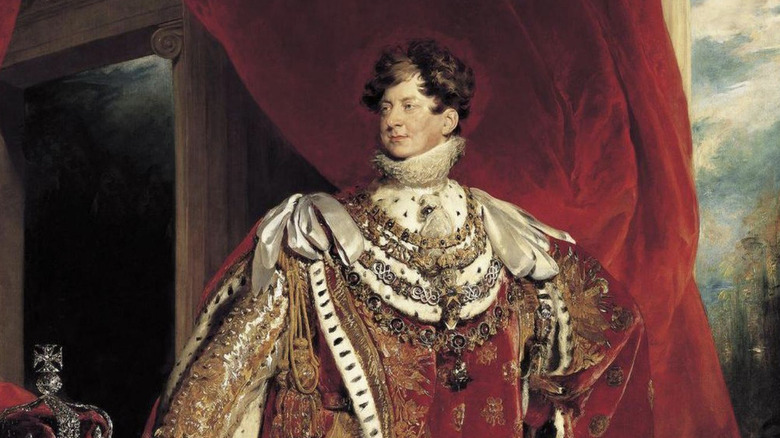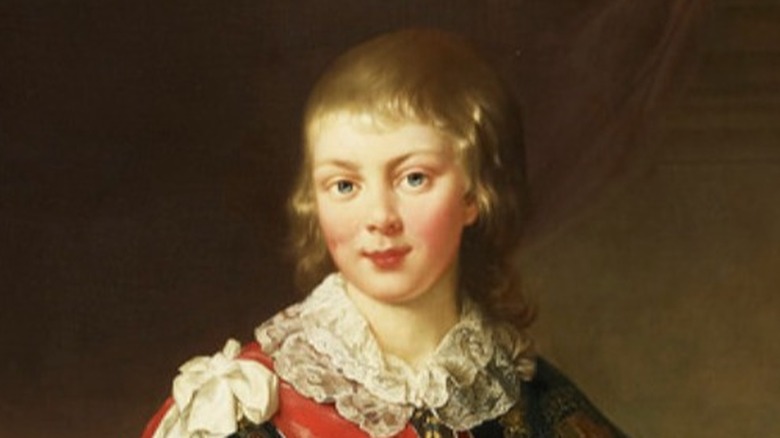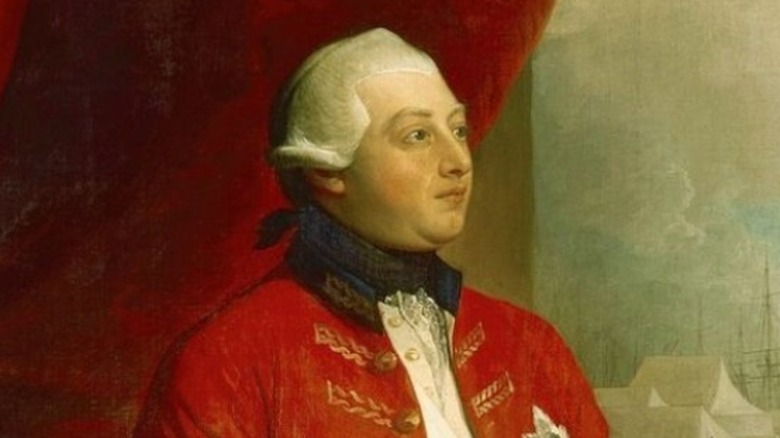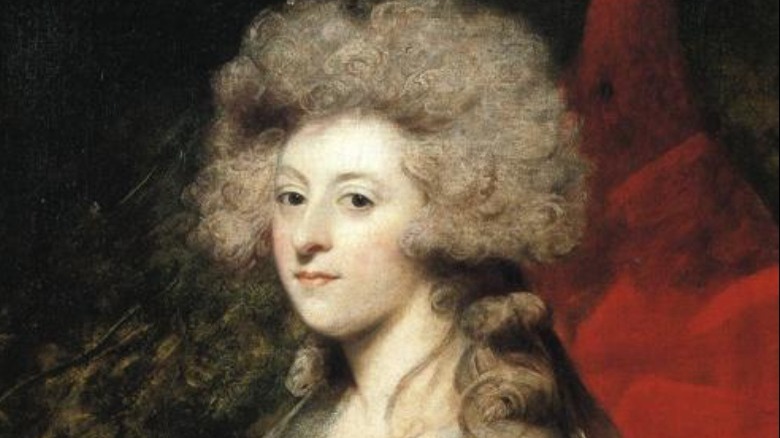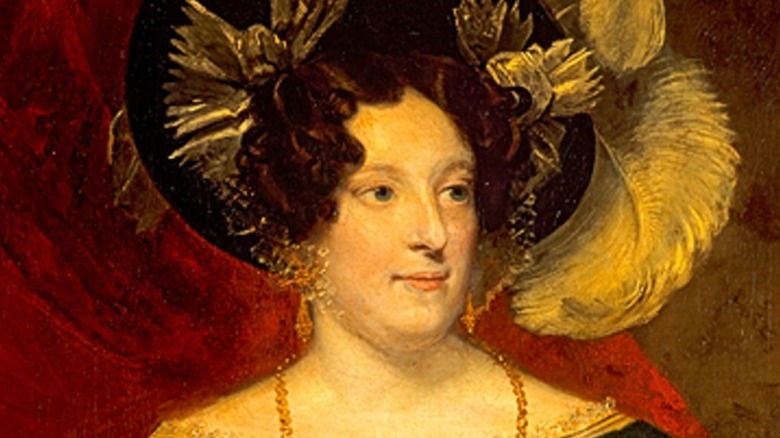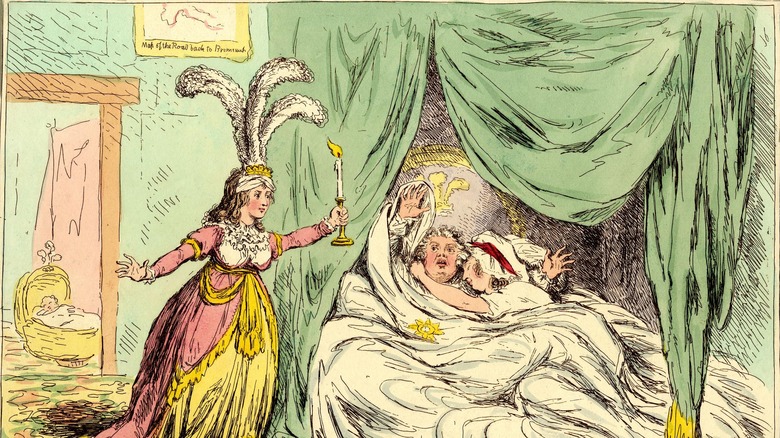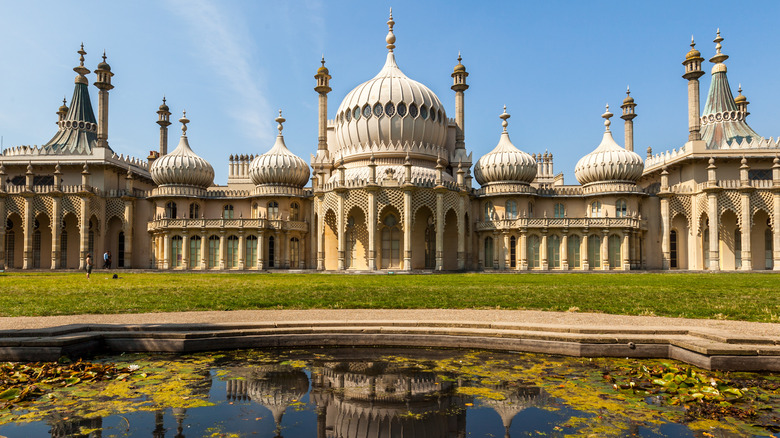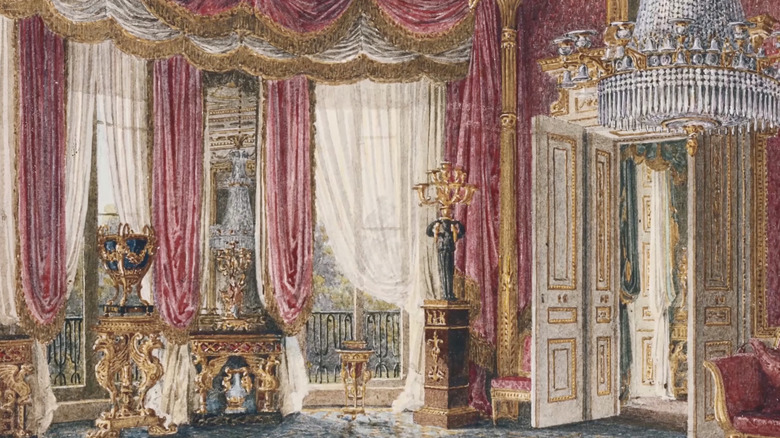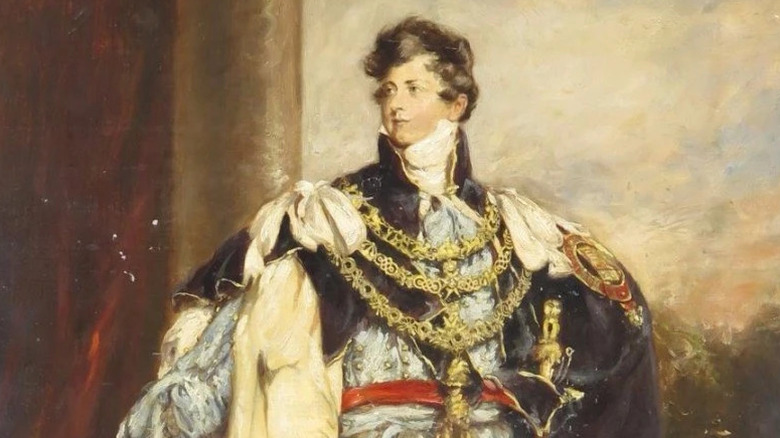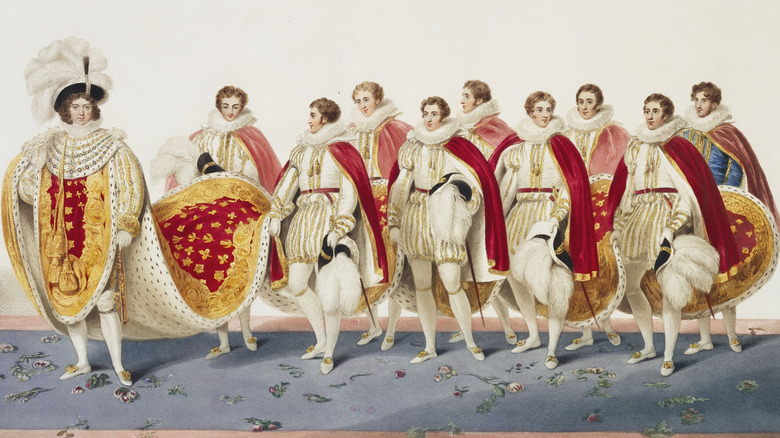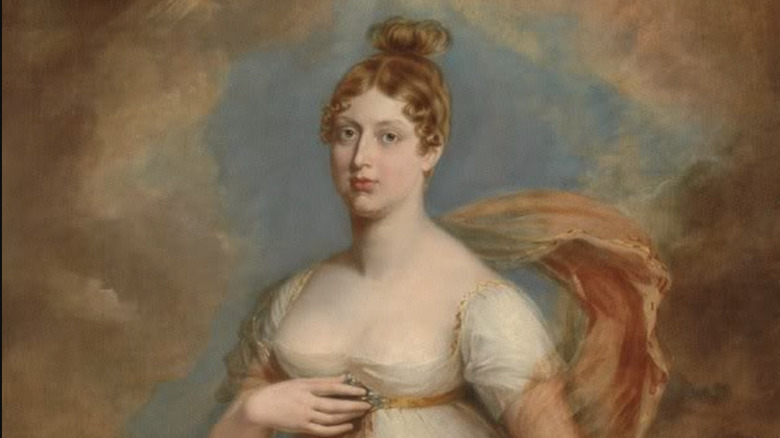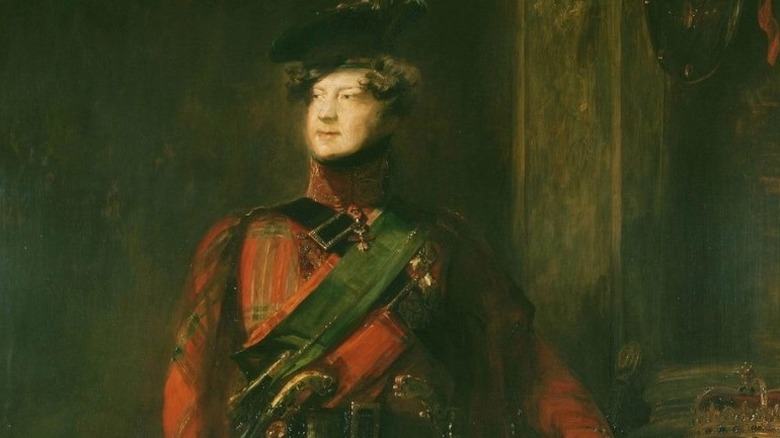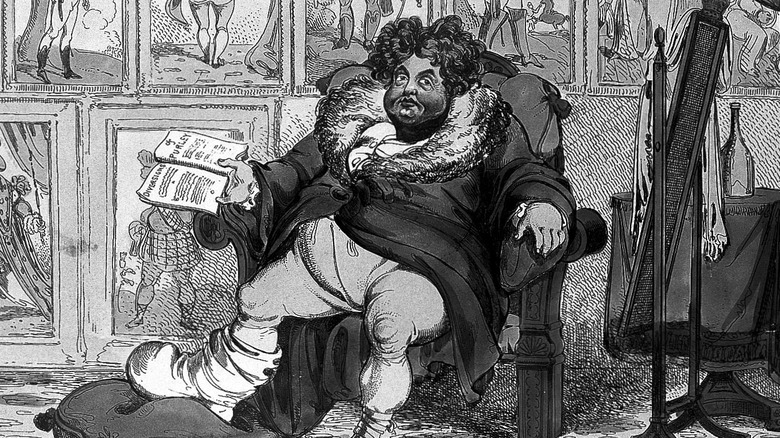The Wild Real-Life Story Of George IV
George IV was probably one of the most reviled monarchs in British history. He was a playboy who spent enormous amounts of money on his lavish lifestyle. His one positive mark on history was his contribution to British art, which is housed across Britain's most prominent museums.
The king was an enigmatic and controversial head of state — one that was both intelligent but also foolish, as described by the duke of Wellington (via Brown University Library). His material obsession gifted the world with priceless artifacts, yet he seemed hell-bent on draining the country's wealth for his own personal image.
From a modern perspective, King George IV, or "Prinny" as he was known, according to Westminster Abbey, lived a life of excess already observed in celebrity culture. He even suffered bad press not too dissimilar to the social media meme storms seen today. So who was the man, the prince, the king who was determined to craft a carefully curated image of himself and the monarchy?
Early years and adolescence
George Augustus Frederick was born on August 12, 1762, and was the eldest of King George III and Queen Charlotte's children. They raised him and his siblings in a very restrictive manner. According to Saul David in his book, "Prince of Pleasure: The Prince of Wales and the Making of the Regency" (via the New York Times), George IV would study for seven hours, between 7 a.m. to 3 p.m. every day and suffer corporal punishment by his father if he misbehaved in the slightest. He did not have a very close or warm relationship with his mother. Her interactions with her children were governed by strict, formal etiquette.
George IV was remembered for being highly intelligent, creative, and charming. Britannica reports he was adept at linguistics and had a keen eye for art. He was a rebellious, mischievous boy who enjoyed pranks, as per "Prince of Pleasure." On one occasion he served a live rabbit to an oboist. He eventually became so obstinate that the king had to fire all of his tutors because they could not reign in his misbehavior.
When he was 18 years old he moved to a private residence at Carlton House, according to the Royal Collection Trust. With more freedom, he gained a reputation for chasing women, excessive eating, drinking, spending, and gambling. George IV's liberal lifestyle and associations with certain politicians eventually became a point of contention for his conservative father, notes Britannica.
His father literally went mad
If the name King George III sounds familiar, it's because he suffered an embarrassing military failure when he lost America in the Revolutionary War. Perhaps his name is familiar for his unfortunate reputation for going mad toward the end of his reign, as the official website of the British royal family reports.
George III showed nothing but dedication to his wife Charlotte — he bought the estate that is now Buckingham Palace for her. Despite being strict, he was known to be a good father and husband. However, he had a contentious relationship with George IV and his other sons, which only got worse after they had secret marriages without his permission. In fact, his son's actions caused George III to make this an illegal act.
Before King George III's mental decline, he was very much the opposite of his eldest son. He was very cultured, he had a massive collection of books he invited scholars to study, and was the first monarch with his own observatory. Unfortunately, the stress from political problems and his unease about his heirs contributed to his ill health.
The Royal Household reports the king suffered a few bouts of illness before becoming mentally incompetent in 1810. Historians believe he may have suffered from a condition called "porphyria," a blood disorder that can cause seizures, anxiety, disorientation, and paranoia among other issues (via Mayo Clinic). He died in 1820 forcing George IV to assume the throne, as per Britannica.
George IV had a secret marriage to a widow
George IV had become infatuated with a widow named Maria Fitzherbert, one of his more famous mistresses. The marriage was scandalous not only because Fitzherbert was a Catholic and would have forfeited George's right to the throne but also because his father did not grant him permission, as per Britannica. Why did her religion matter? At the time British citizens following Catholicism had restricted civil rights and faced harassment (via Britannica). The government offered Catholics no protections either.
To her credit Fitzherbert did not want to be George's mistress. She was eventually coerced into the union, and they were married at her home in 1785 in the presence of a reverend, her uncle, and her brother (via Owlcation). Britannica reports the marriage lasted about seven years until George had to marry his cousin, Princess Caroline. They did continue the affair for a time, but it officially ended sometime around 1808.
The BBC reports she was pushed aside for another mistress, the countess of Jersey. Yet for all the mistresses George IV took, he must have had a special fondness for her. According to Britannica, her miniature portrait was found on his person at his deathbed.
He married Princess Caroline to pay off a debt
It was not uncommon for royal marriages to be loveless relationships, as marriages served a political purpose. George IV's official marriage to his wife Princess Caroline of Brunswick was not out of love or even out of duty. Due to his love affair with gambling and spending money on luxuries, George IV accrued significant debts. The BBC reports that Parliament would pay them off but only if he had a suitable, state-sectioned marriage to another royal.
Princess Caroline was no conventional beauty — she was described as short and fat with an overpowering body odor (via Historic UK). Historic UK also reports George IV was so repulsed by her, that he got drunk on their wedding night and did not immediately consummate it.
He outright rejected Caroline the moment she gave birth to their only child, Charlotte. According to Historic UK, a year into their union he sent her a letter essentially dismissing her to her own devices. She would and with gusto.
The Los Angeles Times reports George IV literally tried to bribe her to stay out of England. He also tried ironically to take legal action against her for infidelity, but the case was dropped. As per Britain Magazine, Caroline arrived at Westminster Abbey for George's coronation but was turned away by guards and left shouting outside. She died 19 days afterward — the words "Caroline of Brunswick, the injured Queen of England" were inscribed on her coffin (via LA Times).
A reputation for womanizing and many mistresses
Aside from Maria Fitzherbert, George IV had many mistresses in his lifetime. The BBC reports he had a fondness for older women in particular. The most well-known were the famed actress and author, Mary Robinson; Frances Villiers, countess of Jersey; and the marchioness of Hertford.
Mary Robinson was his first mistress (as per BBC Radio), and George IV (still a prince at the time) discovered her during a performance of "The Winter's Tale." Robinson began receiving a slew of love letters from the prince not long after he saw her. Their liaisons began continued until he grew weary of her eccentric behavior, as per Saul David's "Prince of Pleasure" (via the New York Times).
One of his mistresses was quite calculating. According to Rachel Knowles, Regency historian and author, Frances Villiers supported George IV's marriage to Princess Caroline. Her rationale was that George would be so disgusted with Caroline, that it would be easier to keep his affections.
Knowles reports his other influential mistress was Elizabeth Hertford. Lady Hertford won his affections in 1806 when he was still married to Mary Fitzherbert. At the time Hertford and her husband had been appointed to watch over Fitzherbert's ward. She influenced George IV by separating him from his political affiliations. Lady Hertford also used her relationship with him to get her family members promoted to high-ranking positions. She was replaced by Elizabeth, marchioness Conyngham, his final mistress, in 1819.
George IV was an architectural visionary
While he was still the prince of Wales, George IV developed an enthusiasm for décor and architecture. His first extreme remodel was on Carlton House, a smaller residence in London that he received at his ascension into adulthood, according to Royal Collection Trust. He filled it with the finest textiles, porcelain objects, and furniture. It was here where he flirted with Asian-themed décor.
In George IV's youth he would often disappear to his private residence in Brighton, then called the Marine Pavilion (via Brighton Museum). After he was crowned king he had architect John Nash rebuild the home into a massive exotic palace resembling those in South Asia. The Royal Pavilion as it's now called is currently a museum and open for tourists.
His influence on architecture is best described as a blend of Gothic elements combined with features from the Middle East, Africa, and other parts of Europe (via Mansion Global). The Royal Pavilion exemplifies this eclectic fusion, particularly with its use of massive domes and minarets.
Windsor Castle was another renovation project of his, and the Royal Collection Trust reveals he commissioned several new additions. George IV had raised the castle's battlements and towers, and the Waterloo Chamber and St. George's Hall were added on. Inside, a large gallery to the Upper Ward was included, and he updated the royal apartments with a new grand staircase.
He had lavish and outlandish spending habits
One thing has remained true about people throughout history: Some live to show off wealth in the most spectacular fashion. George IV had lived a playboy lifestyle. He was addicted to gambling, having amassed the equivalent of more than $800,000 in debt by the time he was in his 30s (via Scottish Field).
Once in 1801, a jeweler publicly accused George IV of non-payment, as Steven Parissien wrote in the biography, "George IV: the Grand Entertainment." Jeweler Nathaniel Jeffreys first posted his grievance in newspapers that he was owed more than £16,000 (approximately $19,000 in 2022). When that failed to catch any of the royal family's attention, he escalated to having a book published in 1806 outlining every pound owed.
Most of George's money went towards his habit of purchasing expensive wares from abroad to decorate his residences. According to the Royal Collection Trust, George bought anything and everything of value. There are thousands of documents preserved by the collection related to the purchases of china, jewelry for his mistresses, clocks, porcelain figures, exotic textiles, and a myriad of commissioned paintings -– he was a collector, to say the least.
George also enjoyed collecting expensive well-crafted furniture from Europe, including the Roentgen desk, which with the turn of a key could trigger its components to unfold.
He had a flamboyant sense of fashion and style
They say imitation is the sincerest form of flattery, and based on the opulence George IV invested in throughout his life, it seems he wanted to compete with Napoleon Bonaparte. The BBC reports in 1811 George was truly trying to outdo the French ruler with all his luxuries, and that extended to his personal style.
As King George IV, he never missed an opportunity to dress up in extravagant costumes. While on a tour of Scotland, he dropped what equates to more than $71,000 on a Highland outfit (via Art UK). It consisted of bolts of satin, velvet, and cashmere tartan, and a host of accessories like golden buckles, a gold and jewel-encrusted badge for his bonnet, and a dagger with emeralds in the hilt. He did not apparently have the bravery to sport naked legs, so he wore flesh-tone pants under his kilt.
The king also had an unusual fascination with military uniforms with all their gleaming medals, cords, and tassels. According to Steven Parissien in "George IV: the Grand Entertainment," George had a fondness for posing in uniform for portraits, so much so he would seek out artists who specialized in painting military attire. The irony is that he never actually served in the military — his father had given him control of a small regiment, but he was forbidden to accompany them for battle campaigns.
His was one of the most expensive coronations in history
Europe's most lavish and expensive coronation had been held by Napoleon Bonaparte in 1804 (as per Brighton Museum), and George IV wanted to ensure this was far more exuberant and decadent. He basically used Napoleon's ceremony as a template for his own. Two things made this event stand above all the rest: the costumes and the staggering amount of money spent to make it happen.
Ever the fashion designer, George IV took elements from the 16th and 17th-century court dress to clothe his precession members. According to Brighton Museum, the costumes garnered a mixed review, with one publication describing some as "grotesque." The procession also had flower-bearing women richly draped leading the coronation to Westminster Abbey.
George must have insisted his coronation occur in style because he had a new crown made with over 12,000 diamonds on it, as revealed by Westminster Abbey's official website. He wore a velvet train covered with gold embroidered stars that required eight people to carry it as he moved, notes Brighton Museum. Beneath the train he sported a suit made of "cloth-of-silver."
Westminster Abbey received a temporary facelift for the occasion. Beyond the special seating arranged for spectators, the abbey's walls and organ were outfitted with a Gothic façade and paneling, Steven Parissien wrote in "George IV: the Grand Entertainment." Historians say the coronation cost at least £9.5 million, according to Brighton Museum – more than $11 million in 2022.
He lost his only daughter to childbirth
Charlotte was the only child produced with George IV's wife, Caroline, born within the first year of their marriage in 1796. George IV declared Caroline forbidden to see her daughter after they separated (via English Monarchs). He took custody of her, and she was raised by an army of governesses, attendants, and private tutors.
Princess Charlotte appears to have had a good relationship with her father, as letters curated by the Royal Collection Trust show she was eager to make her father proud. Despite not always being present for the young princess, George IV was a doting father as he would often send her presents. She had sparing interactions with her mother during her lifetime.
Much like her father, she was a rebellious teenager. Charlotte had some secret relationships around this time, first with her cousin George FitzClarence and later with a lieutenant from the Light Dragoons unit, as English Monarchs reports. Her mother not only supported her relationships, but she would also allow them to be alone in her apartment.
Eventually, after much resistance to her father's choice of suitors, Charlotte was married off to a man of her choosing, Leopold George Christian Frederick of Saxe-Coburg-Saalfield. Her life was cut tragically short at 21-years-old. Charlotte delivered a still-born baby but died later from complications (via English Monarchs). According to the Royal Collection Trust, George IV was so overwrought with grief that he did not attend her funeral.
George IV was a patron of British artists
George IV funded many contemporary artists in his era, including George Stubbs, Thomas Gainsborough, David Wilkie, Thomas Lawrence, and the sculptors Antonio Canova, Francis Chantrey, and Joseph Nollekens. This was yet another way he differed from his father, who did not heavily invest in English contemporary artists, as Steven Parissien wrote in "George IV."
George Stubbs painted a particularly flattering portrait depicting him in the dandy fashions of his youth. The Royal Collection Trust possesses this painting featuring George IV as the prince of Wales dressed in a tall hat, and royal blue jacket with coattails, with curled powdered hair as he rides a chestnut horse. This is one of at least eight paintings George IV bought from Stubbs. He also commissioned him to paint a portrait of a woman he lusted after named Lady Lade, as revealed by Parissien in "George IV: the Grand Entertainment."
Perhaps the most extravagant portrait was painted by Thomas Lawrence in 1821 depicting his coronation. The king is said to have enjoyed Lawrence's work due to his ability to present him in an idealized light (via Parissien). George IV is featured wearing the opulent costume he designed himself with red flowing robes, a high ruffled collar, and numerous links of gold and precious jewels (via Royal Collection Trust).
Being overweight may have killed him
Apparently, the strict diet his father mandated for George was all in vain, according to Brighton Museum – as soon as he was able, he contracted French chef Antoine Carême to prepare him robust meat-heavy meals. George IV went from being denied pie filling to eating specially prepared confectionaries. George IV would also consume copious amounts of alcohol — his favorite, Maraschino, became a regular drink as he aged (via Steven Parissien's "George IV").
All that indulgence meant George IV spent the majority of his life overweight and in poor health. According to Parissien, he suffered bouts of illness as early as his 20s, describing his symptoms as "violent bilious attacks." He would often experience pain and semi-paralysis. To add to his problems, as he aged he became addicted to laudanum.
As time passed, he eventually grew obese and began suffering bouts of gout and other issues. English Monarchs reports it caused him to become reclusive as he was often the subject of caricatures when seen in public. Just eight years after being crowned king, he was forced to sleep upright to avoid asphyxiation, cataracts stole his eyesight, and his arteries had hardened. Doctors would regularly have to drain excess fluid from his abdomen.
His waist measured 55 inches by the time he died. An autopsy showed George IV had a large tumor, an enlarged heart, and died from internal bleeding from the stomach (via English Monarchs).
